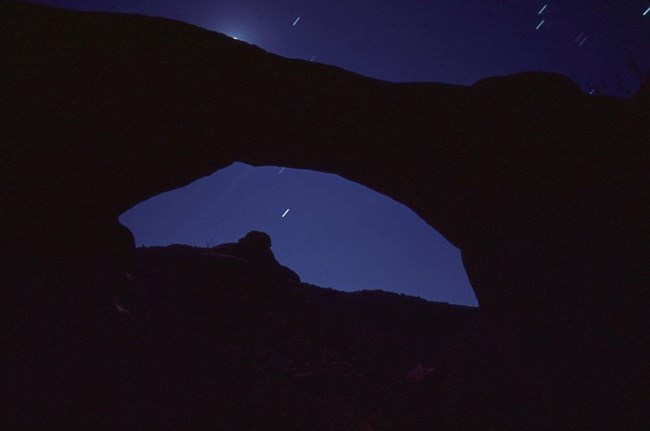
NPS photo by Kayla Wernsing 
NPS photo Imagine sitting at the campground after a long day of hiking and gazing up at the sky. The ancestral Puebloans would have most likely done the same 800 years ago. The open skies of Natural Bridges certainly draw one's attention, and fortunately the night sky is about as dark as it was 800 years ago. National parks preserve some of the darkest skies in the country. In some areas it's possible to see up to 15,000 stars throughout the night. By contrast, in urban environments, you might only see 500 stars or less. You may not realize that light pollution affects more than just astronomers. Nocturnal animals need darkness for survival, and the circadian rhythms of humans and plants rely on an unaltered night sky. Though a multitude of lights create light pollution, these problems can be resolved one light at a time. Due to its remote location, Natural Bridges preserves a primordial dark sky largely unaltered by modernity. The National Park Service wants to keep it that way. To that end, here at the monument, we only use artificial lighting necessary for safety. Motion detectors limit the light needed within restrooms and other areas in the park. All outdoor lighting devices use low-energy, low-impact bulbs with shields that direct light to the ground where it is needed. On March 6, 2007, the International Dark-Sky Association certified Natural Bridges National Monument as the first International Dark Sky Park. The goal of a Dark Sky Park is to preserve the skies and educate the public about light pollution and how they can make a difference. Read more about Natural Bridges on the International Dark Sky Association website. You can review nomination and planning documents. How and Where to Stargaze Natural Bridges trails are open day and night. Stargazing and exploring the night sky is allowed virtually anywhere in the park. No bridges or ruins will be visible from the campground or parking lots. Rangers present stargazing programs in spring and summer. Check the link below for a list of stargazing and astronomy events in southeast Utah, or check the calendar for all upcoming events. Use NASA's Spot the Station app to receive notifications when the International Space Station is visible. |
Last updated: April 29, 2025
